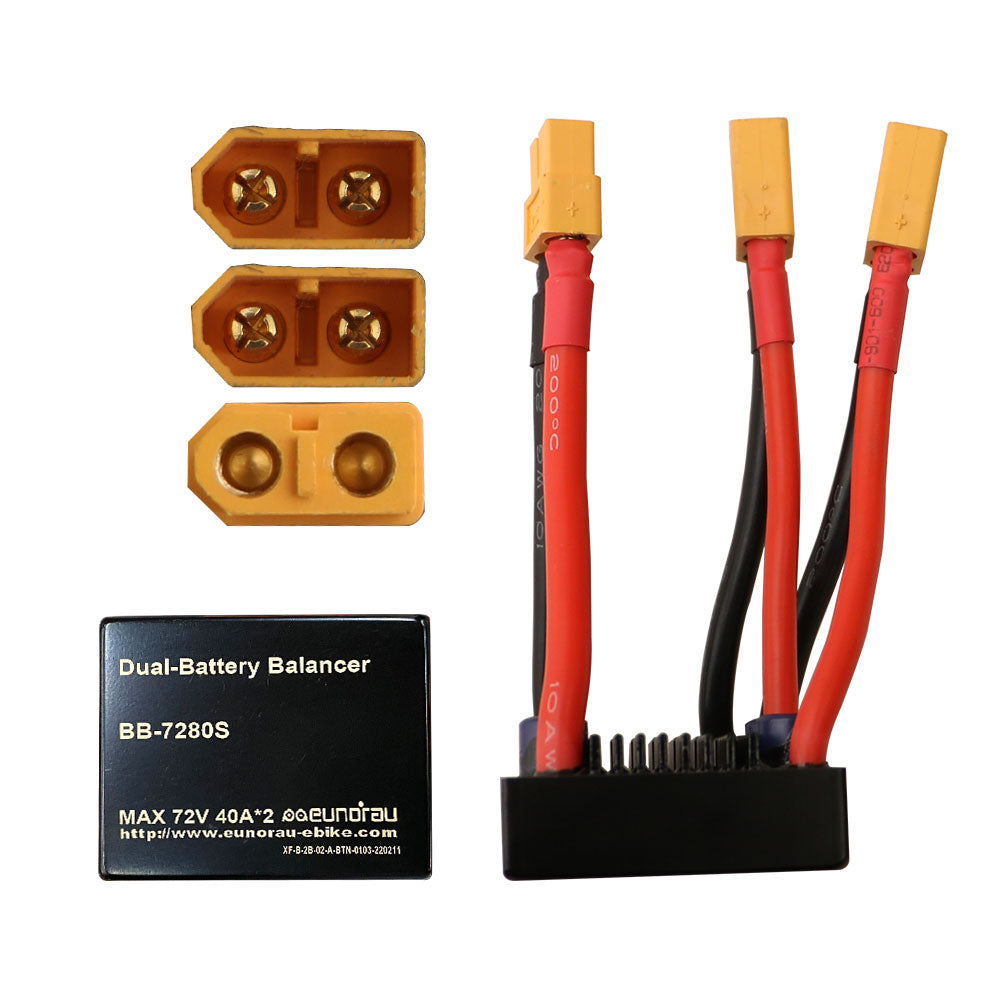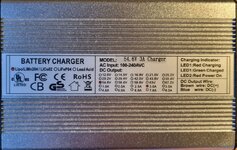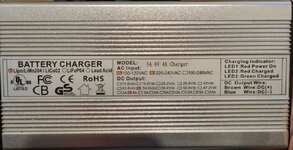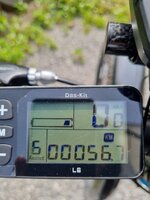You are using an out of date browser. It may not display this or other websites correctly.
You should upgrade or use an alternative browser.
You should upgrade or use an alternative browser.
Reention Dorado 48V 25Ah 29Ah&36V 30Ah (505L) Replacement Battery for eBikes Surface 604,NCM,Rize,Magnum,Aventon
- Thread starter Jenny Mao
- Start date
Jenny Mao
Active Member
- Region
- Asia
Thanks for sharing. It is a mechanical switch to let the battery discharge from one to another as you want. So no concern to maintain the two batteries in same voltage level as the video explains.I found this video on youtube that explains quite well how to connect two batteries in series with a switch.
Your welcome! I also thank you all!! I'm still learning things about the ebikes. So in the end the best choice is a mechanical switch rather than Double Battery Discharge Converter, right? Even if that converter doing everything automatically can be a bit stressful on batteries.
I'm still learning things about the ebikes. So in the end the best choice is a mechanical switch rather than Double Battery Discharge Converter, right? Even if that converter doing everything automatically can be a bit stressful on batteries.
tomjasz
Well-Known Member
- Region
- USA
- City
- Minnesnowta
Which have you used?Eunorau Dual Battery Conveter

EUNORAU 24V/36V/48V/52V/60V Dual Battery Parallel Connector
Specifications: 1.Dual battery converter MAX 72V 40AH*2 2.WIRE 80mm include XT60 end 3.Size 51mm*40mm*12mm Blackeunorau-ebike.com
WattWagons Dual Battery Conveter

Dual Battery Converter - instantly double your riding range!
Have you ever wondered about what to do with all your old ebike battery packs ? Watt Wagons is introducing an incredibly easy way to use your old battery packs and double your riding range. This converter will only work with two packs of the same voltage (e.g. 2x48v, or 2x52v).wattwagons.com
Bolton Dual Battery Parallel Connector

Area 13
boltonebikes.com
I have the Aliexpress version. As Jenny points out there can be downsides to these devices.
I DON'T get increased mileage. There's lots of marginal and sometimes downright incorrect information on YouTube.
I trust my experience over opinions.
If any problems pop up there's no recourse. And no warranties.
tomjasz
Well-Known Member
- Region
- USA
- City
- Minnesnowta
I'd not be happy using a $4 switch. The specifications are worrisome.I found this video on youtube that explains quite well how to connect two batteries in series with a switch.
Type: (ON)/OFF/(ON) ;Connector Type: DPDT ;Power: 15A 250VAC / 20A 125VAC
tomjasz
Well-Known Member
- Region
- USA
- City
- Minnesnowta
UPDATED SWITCH VERSIONIt's so much easier to just use a switch. DPDT
We used an inexpensive voltmeter. The switch has three positions.
View attachment 122949
Frame battery - OFF - Rack battery
View attachment 122952
Be certain the switch you use is up to the task. Confirm the switch specifications. The switch I posted has been used on a dozen bikes but not tested with any pack over 48V(54.6V) and 30A.
Eucrider
Member
- Region
- United Kingdom
So why don't you just put it on a rack and swap when needed it's the best safest optionYour welcome! I also thank you all!!I'm still learning things about the ebikes. So in the end the best choice is a mechanical switch rather than Double Battery Discharge Converter, right? Even if that converter doing everything automatically can be a bit stressful on batteries.
tomjasz
Well-Known Member
- Region
- USA
- City
- Minnesnowta
It's up to you. Others will claim the devices posted work for them. But so far I haven't seen a review of the devices by any source I trust. So far all we see here are the results of someone with no experience searching and finding devices. Given the nature of lithium batteries, I feel safest with a switch.Now I'm a little confused, so in the end should I buy a mechanical switch or a Double Battery Discharge Converter?
tomjasz
Well-Known Member
- Region
- USA
- City
- Minnesnowta
Seriously!? Posters should take the opinions of someone that has no relevant experience just parroting Google searches?I have seen a cheaper ebike using switch, for example budget friendly FTH Power X2-F (covered on EBR YouTube channel), but if you look at ebikes that are a little more expensive, Rize, Juiced, DOST, Ariel Rider, or even higher end bikes like WattWagons or Riese & Muller, they don't use switch.
Obviously it's up to you to go which one, but even if you watch EBR coverage on YouTube, there are tons of dual battery ebikes, and switch seems to be rare.
tomjasz
Well-Known Member
- Region
- USA
- City
- Minnesnowta
Seen is not knowing.I have seen
Jenny Mao
Active Member
- Region
- Asia
This is how dual battery converter works explained by Biktrix. But I haven't figured it out clear myself.  It sounds like the converter smartly keeps switching between the two batteries, makes the two batteries dynamically in same level voltage till the cut off voltage. If so, there is always only one battery discharging at any time. But Biktrix explains it is two batteries discharge together and they advise to operate two batteries at the same time. Quite confused.
It sounds like the converter smartly keeps switching between the two batteries, makes the two batteries dynamically in same level voltage till the cut off voltage. If so, there is always only one battery discharging at any time. But Biktrix explains it is two batteries discharge together and they advise to operate two batteries at the same time. Quite confused.
But if the primary battery is firstly used till ends, and then turn on the secondary battery, to avoid the converter keeps switching. Is this better? Any ideas.

But if the primary battery is firstly used till ends, and then turn on the secondary battery, to avoid the converter keeps switching. Is this better? Any ideas.
Last edited:
Does anyone know why if you charge the battery with a higher amperage charger it discharges faster? I have two chargers, the stock 3A with which the battery came, and I bought another 4A. If I charge the 48v 21Ah (1008Wh) battery with the 3A charger I can cover 100km, and if I do it with the 4A one the autonomy is smaller. I took some pictures today, after 56.7km I had only one bar left, but with that remaining bar I could have covered another 15-20km. Let's say a total of 75km traveled by charging the battery with the 4A charger. So there is a difference of 25km. There are already electric bikes that have 4A or higher chargers in stock, even 10Amps fast charging, and I don't understand why with my 4A charger I lose over 20km that I could have covered. Charging time with 4A charger is somewhere around 5.5hours. Maybe someone will enlighten me.
Attachments
Last edited:
Slaphappygamer
Well-Known Member
- Region
- Other
- City
- over here
Could it be that charging at a higher amperage causes the cells to NOT balance properly? Kind of like when you fill a bucket of water with the hose full open, water will splash out. Topping it off will be harder. As opposed to, filling the bucket slowly so the water doesn’t spill over.
I don't know,it's just an amp difference between them. There are other bikes that come from the factory with 4amp chargers, and scooters that have 10A chargers.Could it be that charging at a higher amperage causes the cells to NOT balance properly? Kind of like when you fill a bucket of water with the hose full open, water will splash out. Topping it off will be harder. As opposed to, filling the bucket slowly so the water doesn’t spill over.
Eucrider
Member
- Region
- United Kingdom
Some chargers cut off earlier , charge with 4amp then plug 3amp in and see if it charges more ,, you could always check with a multimeter from both chargersCould it be that charging at a higher amperage causes the cells to NOT balance properly? Kind of like when you fill a bucket of water with the hose full open, water will splash out. Topping it off will be harder. As opposed to, filling the bucket slowly so the water doesn’t spill over.
Thanks for your advice!! I'll do that next time.Some chargers cut off earlier , charge with 4amp then plug 3amp in and see if it charges more ,, you could always check with a multimeter from both chargers
Last edited:
Hi, may I know your ebike model? It looks same as NCM Moscow. I will invite @Bitmugger to share the testing result, who owns a NCM Moscow and he will test the Dorado 52V 20Ah after the lockdown lifted here.
Hi Jenny,
Yes when I can get my hands on a 52v battery from Aijiu I will be testing it for sure! I know it's in the works.
Similar threads
- Replies
- 8
- Views
- 4K
- Replies
- 105
- Views
- 53K
- Replies
- 1
- Views
- 5K


